2012 SUBARU TRIBECA airbag off
[x] Cancel search: airbag offPage 8 of 420
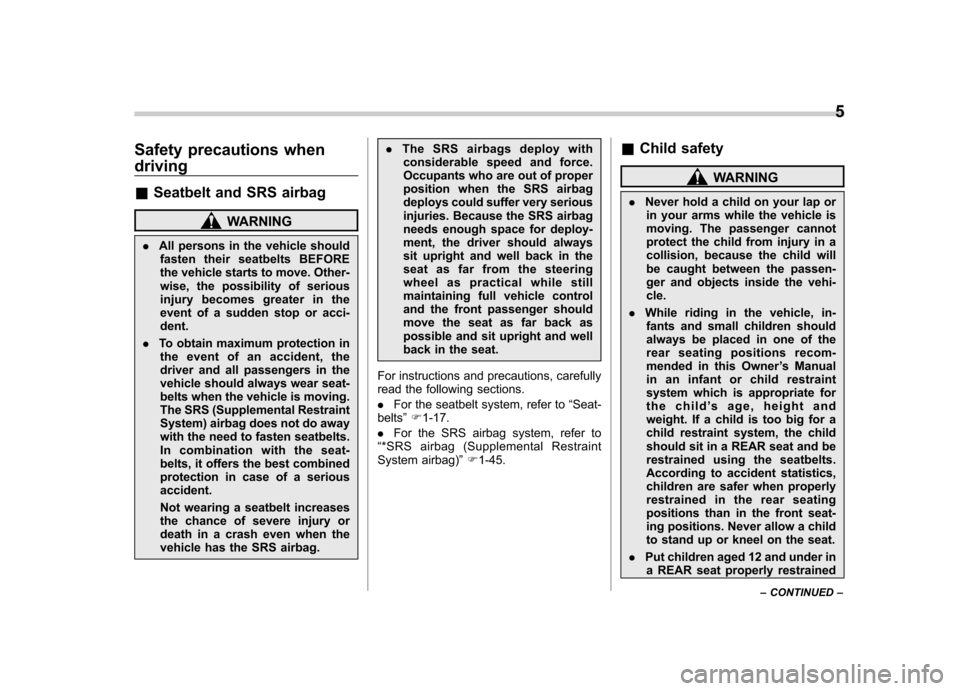
Safety precautions when driving &Seatbelt and SRS airbag
WARNING
. All persons in the vehicle should
fasten their seatbelts BEFORE
the vehicle starts to move. Other-
wise, the possibility of serious
injury becomes greater in the
event of a sudden stop or acci-dent.
. To obtain maximum protection in
the event of an accident, the
driver and all passengers in the
vehicle should always wear seat-
belts when the vehicle is moving.
The SRS (Supplemental Restraint
System) airbag does not do away
with the need to fasten seatbelts.
In combination with the seat-
belts, it offers the best combined
protection in case of a seriousaccident.
Not wearing a seatbelt increases
the chance of severe injury or
death in a crash even when the
vehicle has the SRS airbag. .
The SRS airbags deploy with
considerable speed and force.
Occupants who are out of proper
position when the SRS airbag
deploys could suffer very serious
injuries. Because the SRS airbag
needs enough space for deploy-
ment, the driver should always
sit upright and well back in the
seat as far from the steering
wheel as practical while still
maintaining full vehicle control
and the front passenger should
move the seat as far back as
possible and sit upright and well
back in the seat.
For instructions and precautions, carefully
read the following sections. . For the seatbelt system, refer to “Seat-
belts ”F 1-17.
. For the SRS airbag system, refer to
“ *SRS airbag (Supplemental Restraint
System airbag) ”F 1-45. &
Child safety
WARNING
. Never hold a child on your lap or
in your arms while the vehicle is
moving. The passenger cannot
protect the child from injury in a
collision, because the child will
be caught between the passen-
ger and objects inside the vehi-cle.
. While riding in the vehicle, in-
fants and small children should
always be placed in one of the
rear seating positions recom-
mended in this Owner ’s Manual
in an infant or child restraint
system which is appropriate for
the child ’s age, height and
weight. If a child is too big for a
child restraint system, the child
should sit in a REAR seat and be
restrained using the seatbelts.
According to accident statistics,
children are safer when properly
restrained in the rear seating
positions than in the front seat-
ing positions. Never allow a child
to stand up or kneel on the seat.
. Put children aged 12 and under in
a REAR seat properly restrained 5
– CONTINUED –
Page 20 of 420

&Instrument panel1) Door locks (page 2-5)
2) Illumination brightness control
(page 3-29)
3) Remote control mirror switch (page 3-42)
Power folding mirror switch (if equipped)
(page 3-43)
4) Windshield wiper deicer (page 3-36)
5) Traction Control system OFF switch (page 7-25)
6) Headlight beam leveler (if equipped) (page 3-30)
7) Light control switch (page 3-27)
8) Combination meter (page 3-5)
9) Wiper control lever (page 3-33)
10) Cruise control (page 7-29)
11) Horn (page 3-44)
12) SRS airbag (page 1-45)
13) Tilt steering (page 3-44)
14) Hood lock release knob (page 11-4)
15) Fuse box (page 11-34)
16) Power windows (page 2-21) 17
– CONTINUED –
Page 25 of 420

22
&Warning and indicator lights
Mark Name Page
Driver ’s seatbelt warning
light 3-10
Front passenger
’s seat-
belt warning light 3-10
SRS airbag system
warning light 3-11
CHECK ENGINE warn-
ing light/Malfunction indi-
cator light3-12
Charge warning light 3-13
Oil pressure warning light 3-13
AT OIL TEMP warning light
3-13
/ABS warning light 3-15
/Brake system warning light
3-16
Door open warning light
3-17Mark Name Page
Low fuel warning light 3-17
AWD warning light 3-18
Vehicle Dynamics Con-
trol warning light (U.S.-
spec. models and
Canada-spec. models)/
Vehicle Dynamics Con-
trol operation indicator
light (all models)
3-18
Traction Control system
OFF indicator light (U.S.-
spec. models and
Canada-spec. models)
3-19
Vehicle Dynamics Con-
trol warning light (Latin
America-spec. models)/
Traction Control system
OFF indicator light (Latin
America-spec. models) 3-19
Security indicator light 3-21
Turn signal indicator lights
3-21
High beam indicator light 3-22
Front fog light indicator light3-22Mark Name Page
Headlight indicator light 3-22
Cruise control indicator light
3-22
Cruise control set indica-
tor light
3-22
Low tire pressure warn-
ing light3-14
Passenger airbag ON in-
dicator light
3-12
Passenger airbag OFF
indicator light3-12
SPORT mode indicator light3-21
Windshield washer fluid
warning light3-17
Rear differential oil tem-
perature warning light3-13
Page 36 of 420
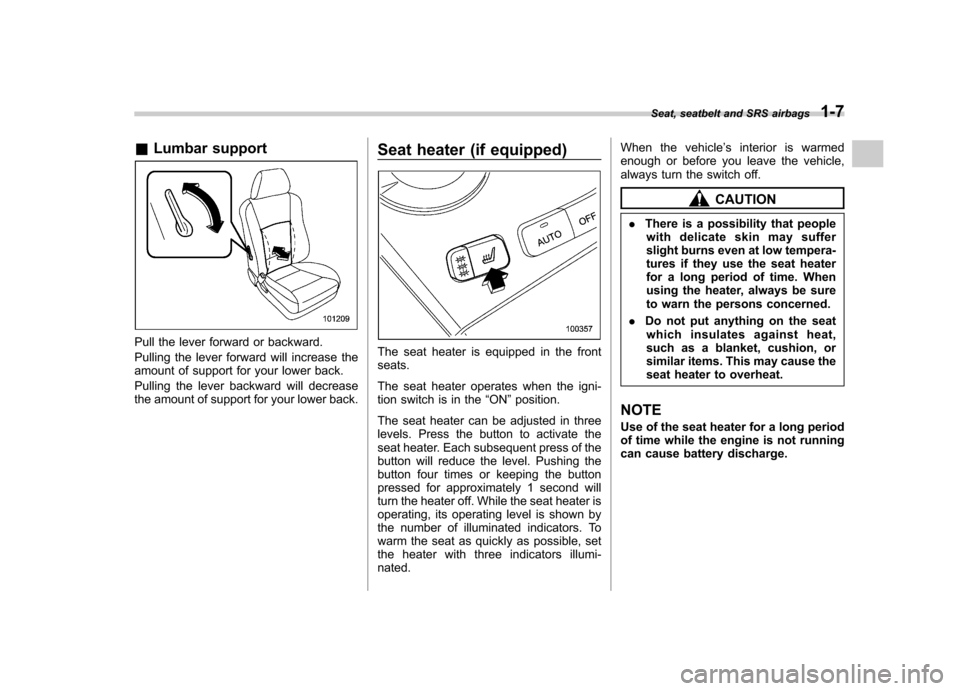
&Lumbar support
Pull the lever forward or backward.
Pulling the lever forward will increase the
amount of support for your lower back.
Pulling the lever backward will decrease
the amount of support for your lower back. Seat heater (if equipped)The seat heater is equipped in the front seats.
The seat heater operates when the igni-
tion switch is in the
“ON ”position.
The seat heater can be adjusted in three
levels. Press the button to activate the
seat heater. Each subsequent press of the
button will reduce the level. Pushing the
button four times or keeping the button
pressed for approximately 1 second will
turn the heater off. While the seat heater is
operating, its operating level is shown by
the number of illuminated indicators. To
warm the seat as quickly as possible, set
the heater with three indicators illumi-nated. When the vehicle
’s interior is warmed
enough or before you leave the vehicle,
always turn the switch off.
CAUTION
. There is a possibility that people
with delicate skin may suffer
slight burns even at low tempera-
tures if they use the seat heater
for a long period of time. When
using the heater, always be sure
to warn the persons concerned.
. Do not put anything on the seat
which insulates against heat,
such as a blanket, cushion, or
similar items. This may cause the
seat heater to overheat.
NOTE
Use of the seat heater for a long period
of time while the engine is not running
can cause battery discharge. Seat, seatbelt and SRS airbags
1-7
Page 69 of 420
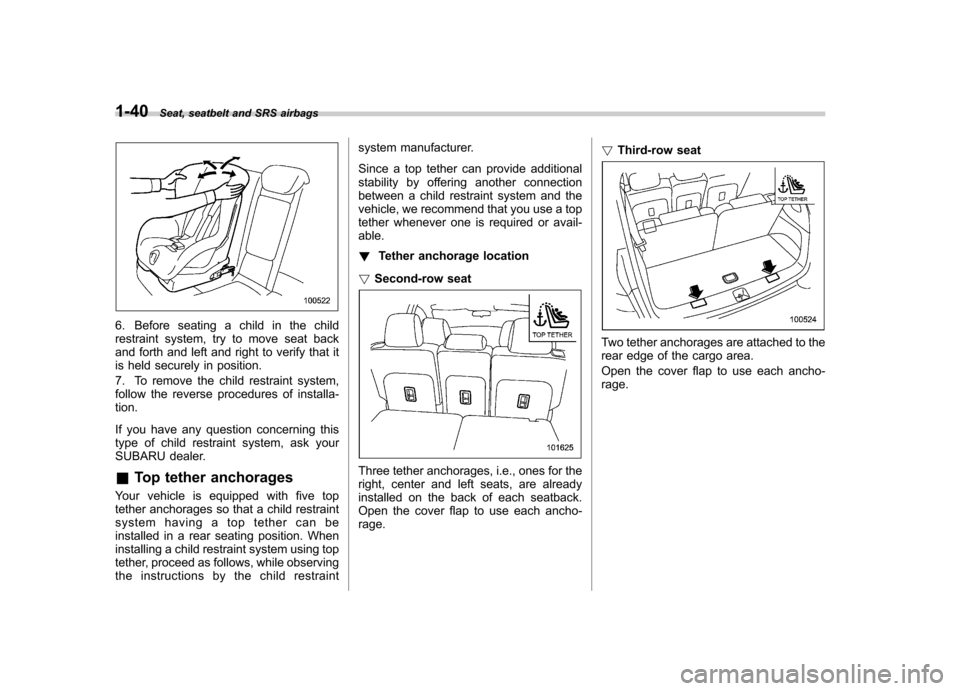
1-40Seat, seatbelt and SRS airbags
6. Before seating a child in the child
restraint system, try to move seat back
and forth and left and right to verify that it
is held securely in position.
7. To remove the child restraint system,
follow the reverse procedures of installa-tion.
If you have any question concerning this
type of child restraint system, ask your
SUBARU dealer. &Top tether anchorages
Your vehicle is equipped with five top
tether anchorages so that a child restraint
system having a top tether can be
installed in a rear seating position. When
installing a child restraint system using top
tether, proceed as follows, while observing
the instructions by the child restraint system manufacturer.
Since a top tether can provide additional
stability by offering another connection
between a child restraint system and the
vehicle, we recommend that you use a top
tether whenever one is required or avail- able. !
Tether anchorage location
! Second-row seat
Three tether anchorages, i.e., ones for the
right, center and left seats, are already
installed on the back of each seatback.
Open the cover flap to use each ancho-rage. !
Third-row seat
Two tether anchorages are attached to the
rear edge of the cargo area.
Open the cover flap to use each ancho- rage.
Page 74 of 420
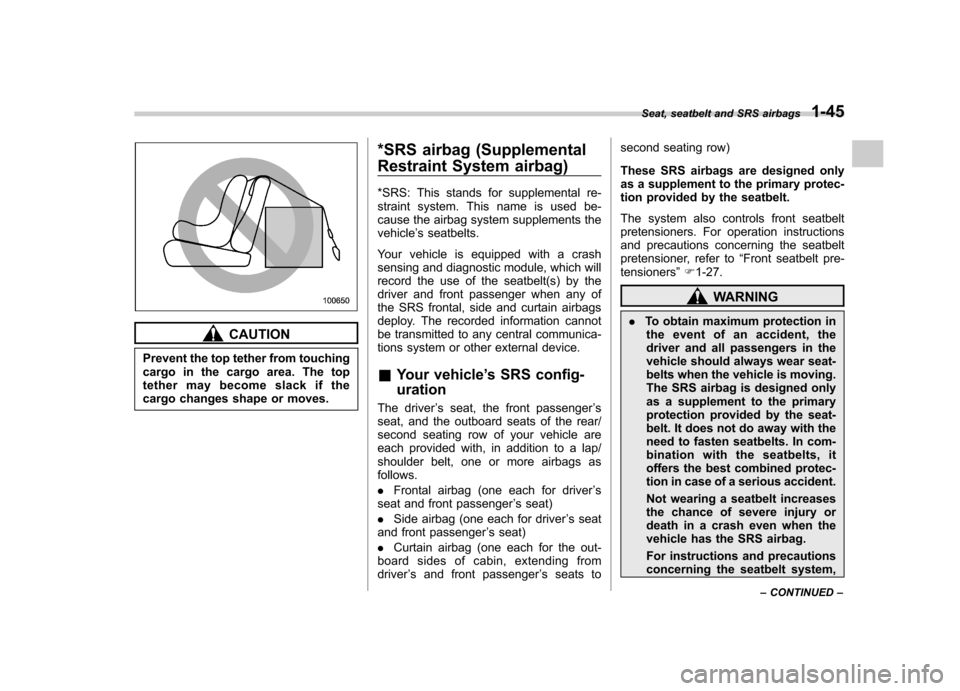
CAUTION
Prevent the top tether from touching
cargo in the cargo area. The top
tether may become slack if the
cargo changes shape or moves. *SRS airbag (Supplemental
Restraint System airbag)
*SRS: This stands for supplemental re-
straint system. This name is used be-
cause the airbag system supplements thevehicle
’s seatbelts.
Your vehicle is equipped with a crash
sensing and diagnostic module, which will
record the use of the seatbelt(s) by the
driver and front passenger when any of
the SRS frontal, side and curtain airbags
deploy. The recorded information cannot
be transmitted to any central communica-
tions system or other external device. & Your vehicle ’s SRS config-
uration
The driver ’s seat, the front passenger ’s
seat, and the outboard seats of the rear/
second seating row of your vehicle are
each provided with, in addition to a lap/
shoulder belt, one or more airbags asfollows. . Frontal airbag (one each for driver ’s
seat and front passenger ’s seat)
. Side airbag (one each for driver ’s seat
and front passenger ’s seat)
. Curtain airbag (one each for the out-
board sides of cabin, extending from driver ’s and front passenger ’s seats to second seating row)
These SRS airbags are designed only
as a supplement to the primary protec-
tion provided by the seatbelt.
The system also controls front seatbelt
pretensioners. For operation instructions
and precautions concerning the seatbelt
pretensioner, refer to
“Front seatbelt pre-
tensioners ”F 1-27.
WARNING
. To obtain maximum protection in
the event of an accident, the
driver and all passengers in the
vehicle should always wear seat-
belts when the vehicle is moving.
The SRS airbag is designed only
as a supplement to the primary
protection provided by the seat-
belt. It does not do away with the
need to fasten seatbelts. In com-
bination with the seatbelts, it
offers the best combined protec-
tion in case of a serious accident.
Not wearing a seatbelt increases
the chance of severe injury or
death in a crash even when the
vehicle has the SRS airbag.
For instructions and precautions
concerning the seatbelt system,
Seat, seatbelt and SRS airbags
1-45
– CONTINUED –
Page 77 of 420
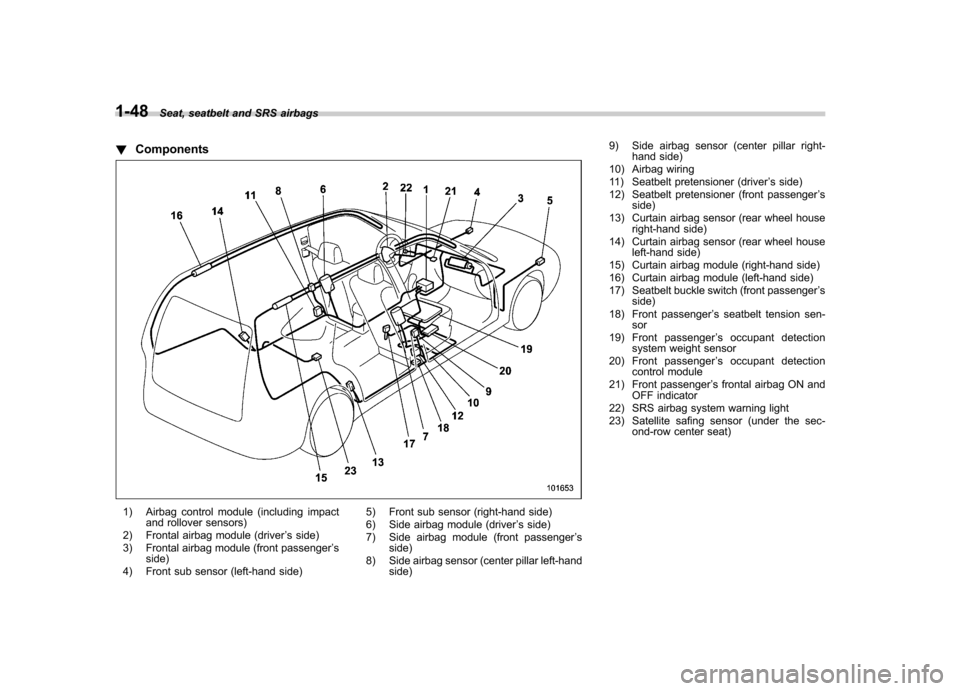
1-48Seat, seatbelt and SRS airbags
! Components
1) Airbag control module (including impact
and rollover sensors)
2) Frontal airbag module (driver ’s side)
3) Frontal airbag module (front passenger ’s
side)
4) Front sub sensor (left-hand side) 5) Front sub sensor (right-hand side)
6) Side airbag module (driver
’s side)
7) Side airbag module (front passenger ’s
side)
8) Side airbag sensor (center pillar left-hand side) 9) Side airbag sensor (center pillar right-
hand side)
10) Airbag wiring
11) Seatbelt pretensioner (driver ’s side)
12) Seatbelt pretensioner (front passenger ’s
side)
13) Curtain airbag sensor (rear wheel house right-hand side)
14) Curtain airbag sensor (rear wheel house left-hand side)
15) Curtain airbag module (right-hand side)
16) Curtain airbag module (left-hand side)
17) Seatbelt buckle switch (front passenger ’s
side)
18) Front passenger ’s seatbelt tension sen-
sor
19) Front passenger ’s occupant detection
system weight sensor
20) Front passenger ’s occupant detection
control module
21) Front passenger ’s frontal airbag ON and
OFF indicator
22) SRS airbag system warning light
23) Satellite safing sensor (under the sec- ond-row center seat)
Page 81 of 420
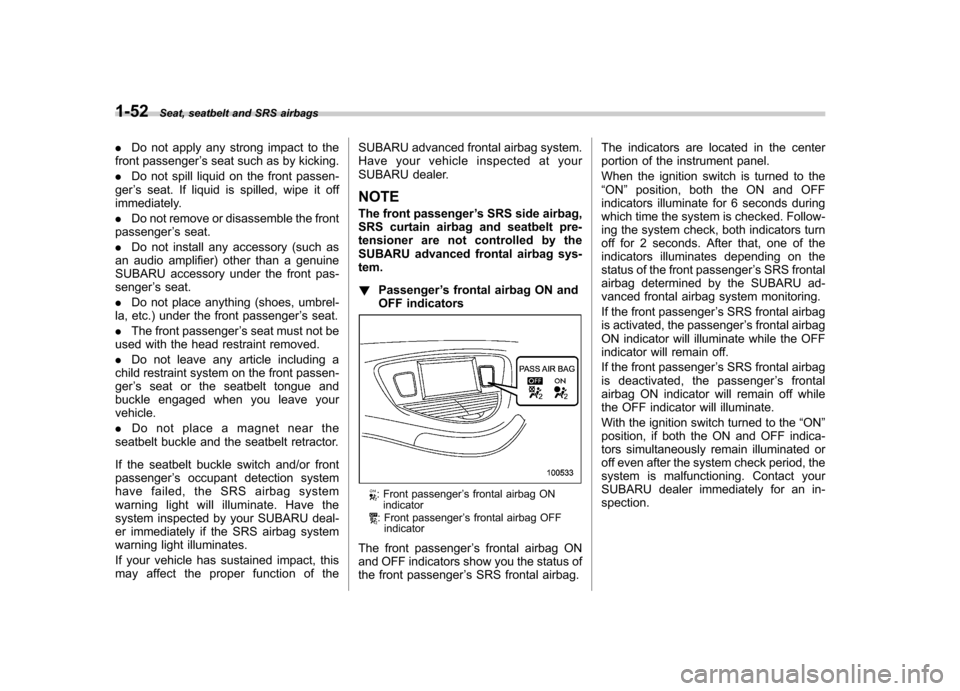
1-52Seat, seatbelt and SRS airbags
. Do not apply any strong impact to the
front passenger ’s seat such as by kicking.
. Do not spill liquid on the front passen-
ger ’s seat. If liquid is spilled, wipe it off
immediately. . Do not remove or disassemble the front
passenger ’s seat.
. Do not install any accessory (such as
an audio amplifier) other than a genuine
SUBARU accessory under the front pas-senger ’s seat.
. Do not place anything (shoes, umbrel-
la, etc.) under the front passenger ’s seat.
. The front passenger ’s seat must not be
used with the head restraint removed. . Do not leave any article including a
child restraint system on the front passen- ger ’s seat or the seatbelt tongue and
buckle engaged when you leave yourvehicle. . Do not place a magnet near the
seatbelt buckle and the seatbelt retractor.
If the seatbelt buckle switch and/or front passenger ’s occupant detection system
have failed, the SRS airbag system
warning light will illuminate. Have the
system inspected by your SUBARU deal-
er immediately if the SRS airbag system
warning light illuminates.
If your vehicle has sustained impact, this
may affect the proper function of the SUBARU advanced frontal airbag system.
Have your vehicle inspected at your
SUBARU dealer.
NOTE
The front passenger ’s SRS side airbag,
SRS curtain airbag and seatbelt pre-
tensioner are not controlled by the
SUBARU advanced frontal airbag sys-tem. ! Passenger ’s frontal airbag ON and
OFF indicators
: Front passenger ’s frontal airbag ON
indicator
: Front passenger ’s frontal airbag OFF
indicator
The front passenger ’s frontal airbag ON
and OFF indicators show you the status of
the front passenger ’s SRS frontal airbag. The indicators are located in the center
portion of the instrument panel.
When the ignition switch is turned to the “
ON ”position, both the ON and OFF
indicators illuminate for 6 seconds during
which time the system is checked. Follow-
ing the system check, both indicators turn
off for 2 seconds. After that, one of the
indicators illuminates depending on the
status of the front passenger ’s SRS frontal
airbag determined by the SUBARU ad-
vanced frontal airbag system monitoring.
If the front passenger ’s SRS frontal airbag
is activated, the passenger ’s frontal airbag
ON indicator will illuminate while the OFF
indicator will remain off.
If the front passenger ’s SRS frontal airbag
is deactivated, the passenger ’s frontal
airbag ON indicator will remain off while
the OFF indicator will illuminate.
With the ignition switch turned to the “ON ”
position, if both the ON and OFF indica-
tors simultaneously remain illuminated or
off even after the system check period, the
system is malfunctioning. Contact your
SUBARU dealer immediately for an in-spection.